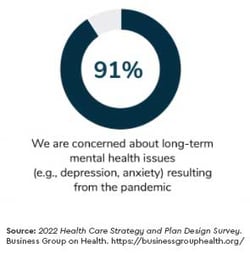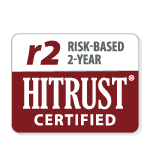The Business Group on Health recently released its annual Large Employers’ Health Care Strategy and Plan Design Survey, which reveals the top healthcare cost trends, benefit design changes, cost drivers, and health policy priorities among U.S. employers for the year ahead.
The 136 employer organizations that took part in the survey, which combined provide health insurance coverage to 8 million people, noted five areas of concern related to the pandemic’s long-term impact on employees.
Here’s our take on how the right predictive analytics partner can help health plans get ahead of the pending trends and provide stronger services for employers.
Concern #1: Expected increases in medical services due to delayed care
Nearly all employers surveyed (94%) anticipate an increase in medical services. This is not surprising, given that more than one-third of Americans (36%) delayed or skipped medical care because of the pandemic, according to an analysis by Urban Institute researchers. One-third of these adults who skipped care said their health condition worsened as a result.
How predictive analytics can help
Predictive analytics offers insights that deliver stronger clinical outcomes and cost-efficiencies, especially when it comes to avoiding disease escalation and high-cost events. A trusted predictive partner can identify more at-risk members earlier, and share the best strategies to engage them, so that plans can intervene sooner and more effectively.
For example, consider the impact of predictive analytics on members with pre-diabetes. Individuals with diabetes incur medical expenses about 2.3 times higher than those without the disease. If members at risk for diabetes are identified and engaged earlier, that can prevent the progression to diabetes and save the direct and indirect costs involved.
Concern #2: Long-term mental health issues spurred by the pandemic are here to stay
 Ninety-one percent of employers are concerned about pandemic-induced and exacerbated depression, anxiety, and other mental health issues, according to the survey. Employers also anticipate greater numbers of people with long-term mental health and substance use issues in the years to come.
Ninety-one percent of employers are concerned about pandemic-induced and exacerbated depression, anxiety, and other mental health issues, according to the survey. Employers also anticipate greater numbers of people with long-term mental health and substance use issues in the years to come.
How predictive analytics can help
Behavioral health conditions are frequently underdiagnosed due to the challenges associated with identifying symptoms early and accurately. Services cannot be limited to the select few who have a severe mental health disorder or those who have the resources to navigate a system where demand is high and supply is low.
Putting predictive analytics to use during this behavioral health crisis is imperative for plans to identify and engage with members sooner. This can include:
- Utilizing AI to identify at-risk members up to 12 months before a diagnosis hits the claim.
- Recommending strategies to promote virtual therapy benefits with repeated touches.
- Connecting the member to an appropriate program early, and before the need for an ER visit.
A savvy predictive analytics provider for behavioral health can boost early risk member identification by 20% to 25%, and increase digital campaign engagement by 50%.
Concern #3: Higher chronic condition management needs
Just over three-quarters (76%) of employers surveyed said they increased telehealth and virtual health offerings during the pandemic—and they plan to keep these options in place over the long term. Yet even with these conveniences, nearly 41% of adults with one or more chronic conditions reported delaying or forgoing care during the pandemic, according to HealthLeadersMedia.
Black adults, especially, reported delaying or forgoing care—and multiple types of care—at a higher rate than white and Hispanic adults. No wonder, then, that 76% of employers anticipate an increased need for chronic condition management services, according to the Business Group on Health survey.
How predictive analytics can help
For members who have already been diagnosed with chronic conditions, an expert predictive analytics provider can help plans increase engagement, consider social determinants, and better align scarce resources. The solution’s proactive care management support should include:
- Providing curated member outreach lists based on risk, cost, drivers, and likelihood to engage, so plans can prioritize resources.
- Recommending personalized engagement approaches for high-risk members based on medical history and engagement preferences.
- Integrating the solution directly into existing workflows to optimize resource allocation and improve efficiency.
Plans that can identify members with heightened risk for chronic conditions have the best chance of helping them avoid sudden and long-term health issues.
Concern #4: Higher prevalence of late-stage cancers due to delayed screenings
More than two-thirds of employers (68%) predict increased diagnoses of late-stage cancers due to postponed or delayed screenings. In truth, this is already a reality: A national survey of radiation oncologists conducted in early 2021 established that two-thirds of new patients were coming in for radiation treatment with more advanced-stage cancers, and that two-thirds of existing patients experienced pandemic-related interruptions to treatment.
These findings were disproportionately unfavorable for Black and other medically underserved populations. The survey surmises that by zeroing in on SDOH circumstances, the health system can tackle underlying social and economic challenges that influence overall well-being.
How predictive analytics can help
An ethical predictive analytics vendor should understand a plan’s SDOH strategy and provide tools to advance health equity initiatives. That includes not only grasping existing equity gaps and risks but providing actionable population and member-driven insights to the social and psychosocial barriers to care.
Because 80% of health determinants occur outside of the health system, a predictive analytics solution must account for social factors, or else the insights will miss actionable data that that influence impact. A vendor must be able to show how it identifies and eliminates bias in its predictive algorithms.
Concern #5: Increased disability claims due to long-term COVID-19 symptoms
The condition known as long COVID-19 has 49% of employers anticipating an increase in disability claims. A report out of Sweden published in April 2021 found that eight months after a mild COVID-19 infection, one out of every 10 people still had at least one moderate to severe symptom that was perceived to have a negative impact on their work, social, or home life.
Many people with disabilities, including those caused by COVID-19, will be unable to return to work, according to one U.S. News & World Report article, which could “overhaul the delivery of disability benefits.”
How predictive analytics can help
This is where a healthcare-specific predictive partner proves its value. The best solutions for plans are developed with—and continually guided by—significant clinician involvement. Factor in predictive models trained on a plan’s specific (versus national) data set, and the resulting insights will prove to be much more accurate and cost-effective.
A truly valuable predictive analytics partner complements existing clinical workflows. A solution with deep healthcare knowledge built into its foundation means less time spent on new implementations and more time helping people enjoy healthier lives.
The goal of most plans is to provide timely, personalized care to members. Because predictive analytics anticipates health problems up to 12 months in advance, and because it relies on patients’ specific attributes (not population averages), it is quickly becoming cornerstone of personalized healthcare.
If you are ready to make the move from treating a patient as an average to treating a patient as an individual, you can improve the quality, efficiency, cost, and patient satisfaction with care. Contact Prealize today or download our buyer’s guide.
